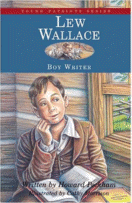Lew Wallace: Boy Writer (Young Patriots Series)
Patria Press, April, 2001.
Hardcover, 112 pages.
ISBN: 1882859057
Ages 9-12
 In the 1950's and 1960's, books known as the
Childhood of Famous Americans series were a well-respected
item on schoolroom and school library shelves. Not only were
stories of the childhoods of famous Americans like George
Washington and Abraham Lincoln in the group, but the stories
of lesser-known persons who achieved greatness in some form
were also included. These books meant a great deal to Florrie
Binford Kichler, who found character qualities that led to
greatness inspiring, so she has decided to republish these stories
as the Young Patriots series. This project will acquaint young
readers with many persons who, although not as famous as presidents,
actually contributed to this nation and to the world. Such a person
was Lew Wallace, a young man who grew up in Indiana and actually
wrote one of the most popular books of all time, Ben Hur.
In the 1950's and 1960's, books known as the
Childhood of Famous Americans series were a well-respected
item on schoolroom and school library shelves. Not only were
stories of the childhoods of famous Americans like George
Washington and Abraham Lincoln in the group, but the stories
of lesser-known persons who achieved greatness in some form
were also included. These books meant a great deal to Florrie
Binford Kichler, who found character qualities that led to
greatness inspiring, so she has decided to republish these stories
as the Young Patriots series. This project will acquaint young
readers with many persons who, although not as famous as presidents,
actually contributed to this nation and to the world. Such a person
was Lew Wallace, a young man who grew up in Indiana and actually
wrote one of the most popular books of all time, Ben Hur.
Lew Wallace certainly did not show much promise in his early years. Although he was descended from John Paul Jones of American naval fame and William Wallace, one of the Scottish Chiefs, Lew appeared more interested in drawing and going for a walk in the woods, or fishing. Although his father was a governor of Indiana, Lew was not a good student, especially when it came to mathematics. The story of Lew Wallace's misadventures in pursuit of an education evokes a time in education that will shock and amaze today's student. To learn how students were beaten for not learning, or humiliated by being placed in a girl's bonnet and being made to sit with the girls for not knowing arithmetic facts, will certainly explain well to students today how much getting an education has changed. Although students who read this story may long for the good old days when getting an education was neither rigid nor regulated, they will most certainly not want to experience a repeat of the beatings that went along with learning.
Students who read about Lew Wallace's youth will be shocked with quite a few things that were generally accepted in the nineteenth century. In the early years of the twenty-first century we do not really expect to lose family members to death, but this was a somewhat common occurrence when Lew Wallace was growing up. He lost a baby brother from scarlet fever, and his mother also later died of unknown causes. One could study law in the office of a lawyer and then practice. When Lew Wallace decides to join the militia to fight in the war against Mexico, he has to attract recruits and then he becomes its leader. The complicated processes to get things done that exist in today's world did not exist in the nineteenth century. Any student who reads this biography will learn a great deal about nineteenth century America, while finding out what makes a young person succeed. Students will enjoy this story for many reasons, but they are most likely to identify with Lew Wallace because the story ends while he is still quite young. Then his later accomplishments are simply listed on the last page.
Martha E. Schaaf has done an excellent job of presenting life as it really was in the nineteenth century in the smaller towns, and in the Midwest in general. She fills the pages with the dangers of runaway horses, as well a the threat of unhappy Indian tribes. The relatively untrained groups that formed the country's first armies look haphazard to the modern reader. The school supplies and dearth of books make us marvel that anyone in those times ever received anything but an unfocused education. Yet these people built a nation which we have inherited in good condition. All of these facts have been skillfully woven into the story of the childhood of one of the nation's most widely read writers. Any student who reads this biography will have learned a great deal of history, as well as what it takes to succeed.
--Sarah Reaves White
Lew Wallace: Boy Writer (Young Patriots Series) is available for purchase on Amazon.com
Note: We may receive a commission from sales made through product links in this article.
This review was published in the Oct. - Nov., 2001 of The Internet Writing Journal.
Copyright © Writers Write, Inc. All Rights Reserved.
